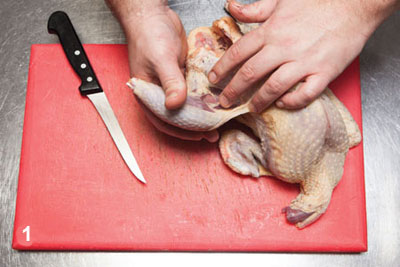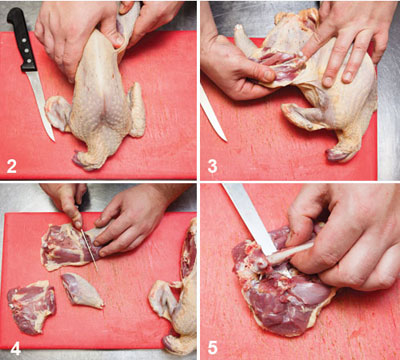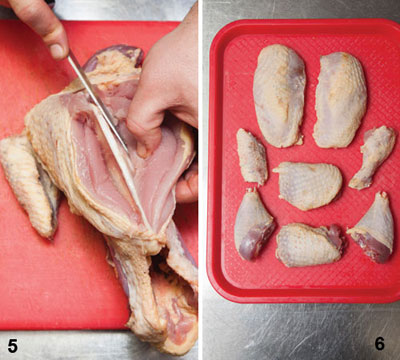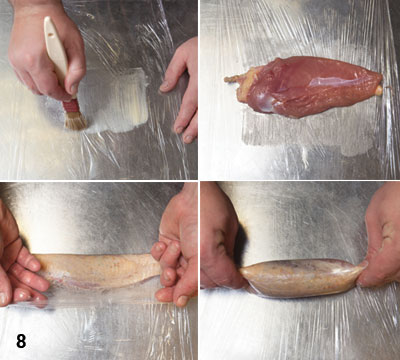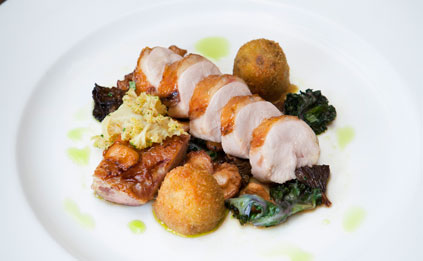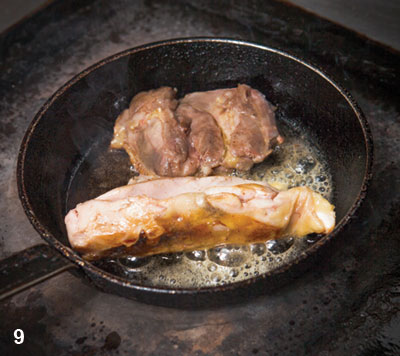Chef masterclass: Guinea fowl by Sam Moody
At the Bath Priory, executive chef Sam Moody cooks guinea fowl with smoked potato croquettes and variegated kales. Michael Raffael reports
"When the game season ends, guinea fowl is ideal for filling the gap," says Sam Moody, executive chef at the Bath Priory. He might have added that it's ideal for those weeks when winter is passing into spring. The taste is stronger than that of a chicken, maybe closer to partridge than to pheasant, with which it's often compared. It has the texture of a young game bird and its weight ranges from 1kg to 1.5kg, oven-ready.
These aren't its only advantages. This is a bird that thrives when free-ranging. Poultry farmers in the UK only stock small flocks. Moody's supplier, Woolley Park Farm, near Bath (www.woolleyparkfarm.co.uk), is typical, slaughtering around 60 birds a week.
So why aren't guinea fowl more popular? The Cyclopaedia of Agriculture (1912) gave two reasons: first, they were seasonal, a stop gap between game and spring chicken, which was once considered a luxury; and second, of all farmyard poultry, guinea fowl were the most temperamental and quarrelsome.
In Europe, they are more established than in the UK. Their story here isn't always upbeat, though. Commercial operations, using barn systems, rear them from hatching to sale in 77 days, as opposed to the four months or more for all extensively raised poultry. Produced like this they lose their distinctive flavour.
Charcoal-grilled with rosemary or mint and pancetta, they are a favourite of northern Italy. In Morocco (guinea fowl originated in Africa) it's cooked with spiced couscous. Yannick Alléno serves it as rillettes in his new Terroir Parisien bistrots.
Sourcing Woolley Park Farm rears guinea fowl to 20 weeks before slaughter. It dry-plucks the birds, essential for a well-flavoured, crisp skin. Hanging is from seven to 13 days at chill temperature according to the restaurant's specification.
Planning • The carcasses are butchered, then the two-day consommé process starts.
•The drumsticks, wings and other lean trimmings are brined and then made into a confit overnight. The confit meat is incorporated in the smoked potato croquettes.
•The variegated kales are blanched and refreshed ahead of each service.
•The thighs and breasts are cooked to order.
Yield and Cost Oven-ready guinea fowl bought wholesale cost around £5.50 per kg. The Priory buys about 12 birds a week. They weigh between 1.2kg and 1.6kg. It aims to achieve four portions per bird on the three-course £80 Á la carte or six on the £95 tasting menu. Moody's target is 71% GP.
Boning and Portioning Although boning a guinea fowl is like cutting up a chicken for sauté, there are several small differences dictated by the end use and by the shape of the bird, which is more angular than a chicken and similar to a pheasant.
Most suppliers will deliver guinea fowl oven-ready, but if this isn't the case, cut off the feet and head, and remove the insides. The birds also have a crop where they store undigested grain: split the skin along the neck and remove it along with the gullet.
The legs Moody retains as much skin as possible for this recipe. Before removing a leg, make a cut through the skin on the inside of the leg where the thigh joins the drumstick (1).
Pull the leg against the joint to dislocate it from the socket (2). Use the tip of a knife to free the leg from the carcass. Repeat with the second leg.
Cut through the natural join between the thighs and drumsticks (3). Cut the bone out of each thigh. Work with the tip of the knife against the bone to expose it, then cut underneath it at both ends to keep loss of meat to a minimum (4).
Reserve the drumsticks for confit
The breasts
Keeping the edge of the blade tight against the bone, make deep cuts on either side of the keel-bone (5).
Following the bone structure, free the breast from the carcass, first on one side, then the other so the breasts are only attached at the wing joints. Cut them both free.
Finally, cut off the wings and separate them from the winglets. Reserve for the confit (6).
Brining
Makes 2 litres, enough for five prepped birds
180g salt
20g pink (curing) salt
2 litres water
1kg ice
6 sprigs thyme
Put the salt, curing salt and 1 litre of water in a pan. Stir while heating to dissolve the salt. Cool and add the ice. Transfer the brine to a large, deep-sided container and add the rest of the water and the thyme. Add the breasts and 
thighs and cure for four hours. Drain the pieces and pat dry (7).
Water bath To prepare each breast, spread a sheet of clingfilm on a work surface or chopping board and brush it with softened butter. Lay the breast on the film, then roll it up so it's encased in several layers, and secure both ends to obtain 
a rough cylinder shape. Seal each prepared breast and each thigh in an individual vacuum sachet (8).
Poach for two hours in a water bath at 65°C. Chill and reserve for service.
Confit Moody brines the drumsticks, wings and lean trimmings, then cooks them overnight (or for eight hours) in duck fat to make the confit.
Smoked potato croquettes Steam potatoes as for mash, then rice or 
sieve them. Combine with plenty of smoked butter, a little milk, grated lemon zest and 
flaked guinea fowl confit. Chill until the mixture 
is fairly stiff.
Roll out to form cylinders about three centimetres thick. Cut into portions weighing 
40g each -the size of a bantam egg. Coat the croquettes in seasoned flour, beaten egg and breadcrumbs. Set aside ahead of service.
GUINEA FOWL CONSOMME The basis of the consommé is a 10-litre batch of court bouillon prepared with beef shin, turkey leg and a boiling fowl.
Chop the carcasses of 10 guinea fowl into pieces and caramelise them in the oven or on top of the range. Put them in a pan and pour over court bouillon. Simmer for four hours, strain and chill. Remove any fat on the surface. Season. Leave overnight.
Bring the liquid back to a simmer. Blend 100g guinea fowl [or chicken] livers with tarragon stalks in a Robot Coupe. Combine with 200g beaten egg whites and 2-3tbs crushed ice. Whisk into the stock and allow it to percolate at the side of the range for 20 minutes.
Pass the consommé through a muslin bag, then chill and vac-pack in 100ml sachets for portion control. This should yield about 6 litres.
WOOLLEY PARK GUINEA FOWL, SMOKED POTATO CROQUETTES, VARIEGATED KALES

Serves 2
2tbs sunflower or pomace oil
1 large prepped guinea fowl breast
1 guinea fowl thigh
50g butter
4-6 variegated kale leaves
Salt
50g seasonal wild mushrooms - eg, chanterelles
Squeeze of lemon juice
Pinch chopped chives
2 confit guinea fowl croquettes + frying oil
100ml consommé
1tbs tarragon oil
Brush a little oil on a plancha (set at a moderate heat). Put the rest of the oil in a small frying pan. Put the guinea fowl thigh on the plancha skin-side down, to cook out slowly and crisp the skin. Gently fry the rolled breast in the pan, turning it like a sausage. When both sides have cooked (about 10 minutes) put the leg with 
the breast, add half the butter and sauté for a minute or so (9).
Cook the kale leaves in boiling salted water and drain (10).
Sauté the mushrooms in the rest of the butter. Season and finish with a squeeze of lemon juice and the chopped chives.
Deep-fry the croquettes at 180°C until 
crisp (11). Drain on absorbent paper and cut them both in half across the middle (12).
Reheat the consommé.
To plate both portions: cut the thigh in half (trim the edges if necessary for presentation). Slice the breast into 10 pieces. Divide the mushrooms between the two plates. Lay overlapping breast slices on top, with a piece of thigh to one side. Add the kale and halved croquettes. Finish with consommé and 
tarragon oil.
Tips
•Don't overpack the brine with pieces of meat or it won't penetrate evenly.
•Moody uses 50/50 neutral and olive oils for his tarragon oil so the herb flavour is dominant.
•Adding crushed ice to egg white and liver for clarification prevents the mixture from coagulating too rapidly.
•Smoked butter from Valley Smokehouse 
(www.valleysmokehouse.com) gives an extra zing to any kind of mashed potato.



